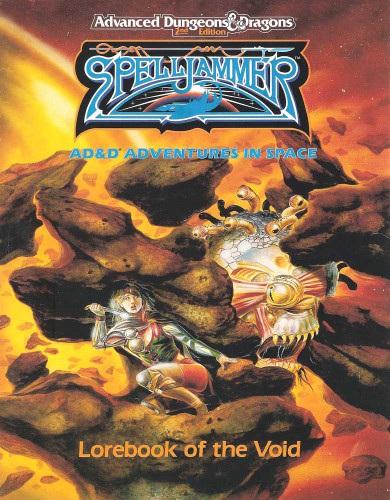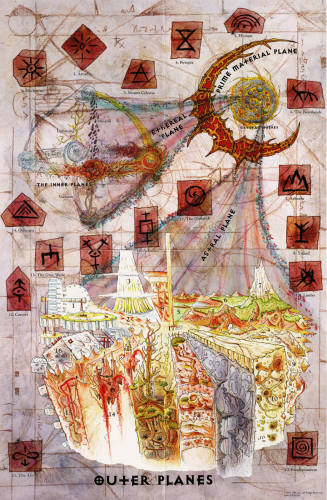I started roleplaying with the Finnish edition of Dungeons & Dragons, and graduated to playing Advanced Dungeons & Dragons 2nd Edition as soon as I learned enough English to read the books.
While there’s been good and interesting stuff done in the 3rd, 4th and 5th editions of the game, for me the one true D&D will always be the 2nd edition. Not because of the rules, but because of the world.
TSR published a number of campaign settings in which the game could be played. Forgotten Realms, Dragonlance, Dark Sun, Birthright, and so on. However, they were not content with just creating different fantasy worlds. They also created a unified superstructure into which all those worlds fit.

Crystal Spheres
In addition to the normal campaign settings published for AD&D 2nd Edition, TSR published two “meta-settings”. The first was Spelljammer, and the second Planescape.
Spelljammer is D&D in space. It presents a universe where solar systems are held in vast crystal spheres floating in a combustible substance called Phlogiston. Ships (I mean wooden sailing ships) could be fitted with a magical device called “The Spelljamming Helm” and used to travel to other planets as well as between the crystal spheres.
Best of all, all the normal campaign worlds were seen as parts of this overarching vision: You could fly your spaceship from the world of Forgotten Realms to the world of Dragonlance.
From this perspective, all the worlds of D&D were in fact the same world, sort of like the Marvel Universe of D&D. From the perspective of an individual campaign, it didn’t matter too much, but for a D&D geek like me, it was heady stuff.

Infinity
Other planes of existence had been a part of D&D from a pretty early stage, but they didn’t really come into their own until the introduction of Planescape. Like Spelljammer, Planescape connected existing worlds, this time through a structure of infinite planes composed of various moral or physical ideas.
The planar cosmology was pretty complicated. The crystal spheres composed a Prime Material Plane, which contained normal worlds. It was connected to the Inner Planes through the Ethereal Plane and the Outer Planes through the Astral Plane. The Inner Planes were organized around elemental ideas: fire, water, earth, air, life and death, as well as connecting planes, such as radiance or ash. The Outer Planes were moral, with Lawful Evil Baator and the Chaotic Neutral Limbo. The Outer Planes naturally had sublevels, which were also infinite.
In the center of the Outer Planes stood an infinitely tall mountain, and on top of the mountain floated the donut-shaped Sigil, City of Doors.
So by this point you could safely say that the world of D&D had grown pretty complicated.

Back to Earth
In the Wizards of the Coast versions of D&D there’s been a clear shift away from all this towards a more grounded vision of the game. Published books have been more about stuff you can use in a normal fantasy campaign. Other planes of existence have been stunted and sheared into something like a spice or a topping you can use to flavor a game. They’re no longer the place where it all happens.
I understand why. All that stuff was crazy complicated, and appealed mostly to hardcore fans, at least if the sales numbers for Spelljammer and Planescape are anything to go by. The world had floated far beyond anything resembling the basic fantasy roots of D&D.
Still, I’ve never lost my love for the various infinities of the planes. When I first read Planescape, I thought it was the coolest thing ever published. Now, years later, I still appreciate the worldbuilding vision the designers of the 2nd edition had, where every place, from the Asteroid Belt to the City of Brass on the Plane of Fire, was a possible place of adventure.
Two metasettings?
Would you then place Ravenloft beneath the Planescape umbrella?
Let’s not get crazy 🙂 Ravenloft is a setting of its own, obviously.